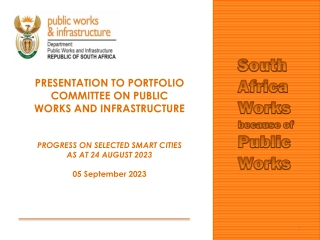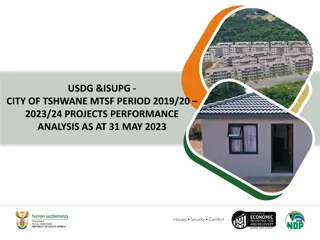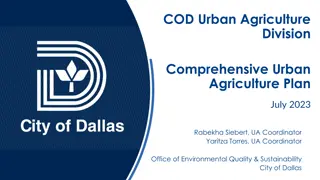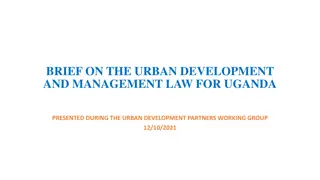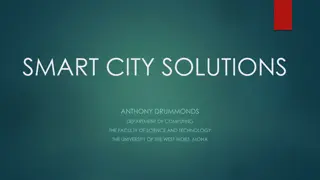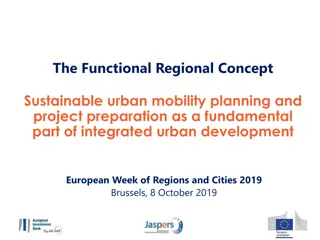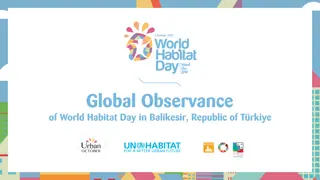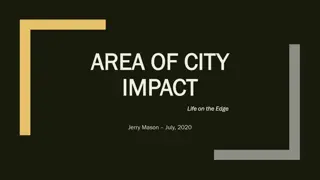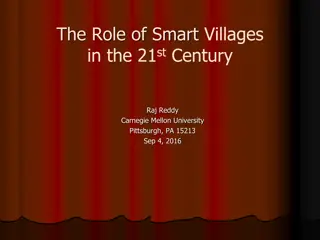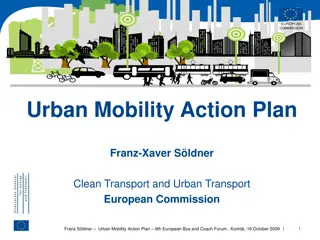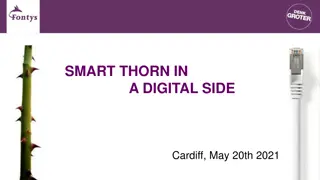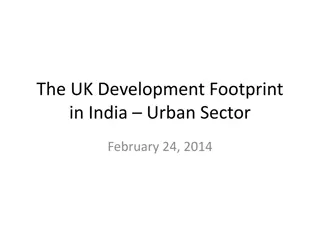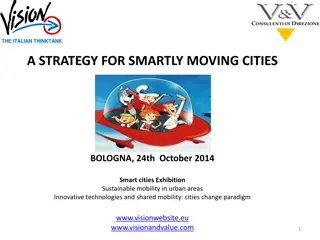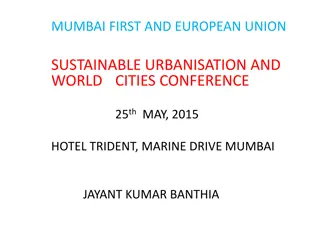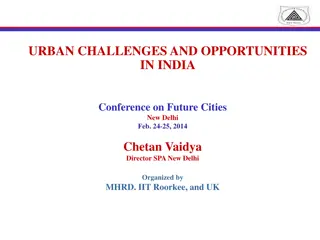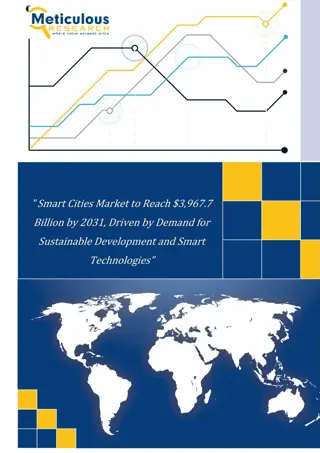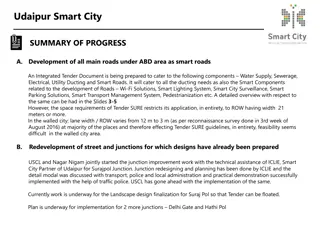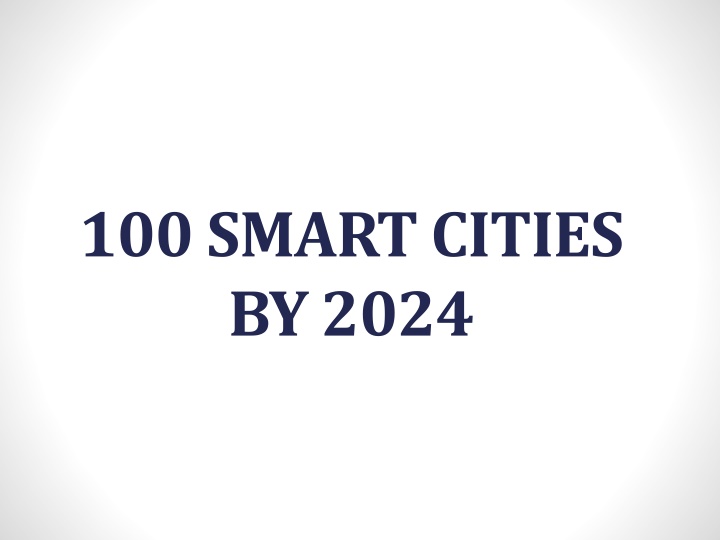
Transforming Urban India: Smart City Development
Amidst the rapid urbanization in India, the mission of establishing 100 smart cities by 2024 is outlined, focusing on pillars like sustainability, innovation, and citizen engagement. The approach involves comprehensive development strategies and leveraging technology for a better quality of life.
Download Presentation

Please find below an Image/Link to download the presentation.
The content on the website is provided AS IS for your information and personal use only. It may not be sold, licensed, or shared on other websites without obtaining consent from the author. If you encounter any issues during the download, it is possible that the publisher has removed the file from their server.
You are allowed to download the files provided on this website for personal or commercial use, subject to the condition that they are used lawfully. All files are the property of their respective owners.
The content on the website is provided AS IS for your information and personal use only. It may not be sold, licensed, or shared on other websites without obtaining consent from the author.
E N D
Presentation Transcript
100 SMART CITIES BY 2024
Presentation Outline Context Comprehensive Four Pillars of Smart City Selection and Conditions Precedent Strategy & Approach Proposed Funding Way forward & Timelines 2
Urban India 2014 2030 31% population 40% population 63% of GDP 75% of GDP 80% of 2030 Urban India still to be built A new Chicago needs to be built every year 3
Mission intends to make National Priorities a Reality Leverage Innovation & Technology EGov, Digital India Swachh Bharat Zero Emission Involve Citizens in Policy as well as Execution Employment Generation Make in India Improve Quality of Life 4
How is it different? Comprehensive Development Area approach rather than the earlier Project approach Leveraging Government Funds to attract Investments Competition to Select Cities from shortlisted 100 Based on Commitment to National Priorities (EGov, Swachh Bharat, Make in India) 5
Comprehensive Development: Four pillars of a Smart City Employment Quality of life Sustainability Disaster Management & Resilience Technology Enablement Institutional infrastructure Physical infrastructure Social infrastructure Economic infrastructure Institutional infrastructure Physical infrastructure Social Economic infrastructure infrastructure Citizen Engagement 6
ILLUSTRATIVE LIST Smart Solutions Basic Infrastructure Energy Management E-Governance and Citizen Services 1 Public Information, Grievance Redressal 13 Smart Meters & Management Electronic Service Delivery 2 Renewable Sources of Energy 14 3 Citizen Engagement 15 Energy Efficient & Green Buildings Citizens - City s Eyes and Ears 4 5 Video Crime Monitoring Urban Mobility Waste Management 16 Smart Parking 6 Waste to Energy & fuel Intelligent Traffic Management 17 Waste to Compost 7 18 Integrated Multi-Modal Transport 8 Every Drop to be Treated Treatment of C&D Waste 9 Others Water Management 19 Tele-Medicine 10 Smart meters & management Incubation/Trade Facilitation Centers 20 Leakage Identification, Preventive Maint. 11 21 Skill Development Centers 12 Water Quality Monitoring Different Cities Different Smart Solutions Leveraging Local Innovations 7
Shortlisting of Cities (Indicative list) Cities accounting for 54% of Incremental GDP till 2025* 1. Economic Criterion 69 Cities accounting for 54% of Incremental GDP till 2025* 69 2. Geographic Inclusivity 12 All State Capitals (not included above) All State Capitals (not included above) 12 8 Tourist/ Religious Heritage (not included above) Tourist/ Religious Heritage (not included above) 8 Hill and Coastal Areas (not included above) 4 Mid-sized Cities (not included above) 7 100 8 *Source: McKinsey Global Institute, Understanding India s economic geography, , October 2014
Conditions Precedent 1. Municipal Reforms Double Entry Accounting System Minimum 50% collection of Taxes and User Charges Creation of Municipal Cadre 2. E-Governance Electronic Delivery of Public Services All Information in Public Domain 3. Zero Emissions: Solid & Liquid Waste 4. Master Plan based on Spatial Mapping/GIS 9
Strategy & Approach 1. Pan-City Development Citizen Engagement and Reference Framework Capacity Building E-Governance Zero Emission City Development Plan based on Spatial/ GIS Mapping, ICT, Environmental Sustainability 2. Exemplary Development through City Challenge Retrofitting - 500+ acres Redevelopment - 50+ acres Green-Field Development - 250+ acres 3. Pan-City 2-3 Major Infrastructural Projects 10
Retrofitting development Existing Developed Area Minimum 500 acres in size Where? Zero Emissions- Solid & Liquid Discharge Quality Electricity & Water Supply: Smart Metering High-Speed, High-Bandwidth Connectivity CCTV Surveillance of all public areas LED lighting, Intelligent Traffic & Parking Management Pavements, Cycle Tracks, Roads What? Implementation in 3 years SPV (ULB, State, Centre) Selection through Competition City Challenge How? 11
Redevelopment Existing Urban Sprawl (including Railway, Bus Stations etc.) Minimum 50 acres in size Where? In addition to all retrofitting components Higher FAR and Lower Ground Coverage Green and Energy-Efficient Buildings Wide Roads; Recreational, Open Spaces What? Mixed Land Use Higher FAR Max. 50% ground coverage Max. 40% Commercial, Min. 10% Institutional, Min. 10% for Parking MoU with States, ULB, Developers Mixed Land Use & Higher FAR Max. 50% ground coverage Max. 40% Commercial, Min. 10% Institutional, Min. 10% for Parking MoU with States, ULB, Developers Condition- alities Implementation in 5 years SPV (Public/Private Developer) Equity Participation by GoI, States, ULBs Selection through Competition City Challenge How? 12
Green-Field Townships Vacant Land Minimum 250 acres each Township Where? In addition to all Redevelopment components Quality infrastructure for Education, Health and Recreation Multimodal Transport Trade Facilitation, Incubation, Skill Development Centres What? In addition to all redevelopment conditions High Speed Rail/Road Connectivity MoU: States, ULB, Developers In addition to all redevelopment conditions High Speed Rail/Road Connectivity MoU: States, ULB, Developers Condition- alities Implementation in 5 years SPV (Public/Private developer) Equity Participation by GoI, States, ULBs Selection through Competition City Challenge How? 13
Proposed City Challenge Matrix Commitment to National Priorities E-Governance Swachh Bharat Make in India Retrofitting Development Redevelopment Greenfield Development 14
Proposed City Challenge Process Online applications by States/ULBs/Developers Highlighting Initiatives, innovations and Impact Evaluation and Selection by Committee of International and Indian Experts Allocation of Funds by Empowered Committee (GoI, States, ULBs) 15
Proposed Funding (per city) PHASE 1 (3 years time horizon) Retrofitting Development (of 500 Acres) Rs.150 Cr Capacity Building, Citizen Engagement, PMU, CDP Rs. 50 Cr E-governance & Online Public Services Rs. 50 Cr PHASE 2 (5-10 years time horizon) Equity Participation in Redevelopment Rs.100 Cr* Equity Participation in Green-Field Townships Rs.100 Cr* 2-3 Major Infrastructure Projects Rs. 550 Cr Rs. 1,000 Cr *Proposed to be pulled out after 5 years @predetermined return or market value, whichever is higher 16
Way Forward & Timelines Identification of Cities 31/01/2015 Issuance of Policy 28/02/2015 Implementation Fast Forward 3 years Retrofitting 5 years Redevelopment Green-field 5-10 years Citizen Reference Framework 30/06/2015 City Development Plan (with Environmental Vetting) 30/09/2015 Implementation Full Blown 5-10 years 17
Institutional Infrastructure Minimum Government, Maximum Governance o EGovernance 24X7 Online Public Service Delivery o Ease of Doing Business Citizen Engagement Safety, Security, Enforcement Transparency & Accountability Disaster Management & Resilience Back 19
Physical Infrastructure Zero Emission: Solid & Liquid Waste 24x7 Power Supply Assured & Metered Water Supply High-Speed Broadband Connectivity Multimodal Public Transport Back20
Social Infrastructure Inclusive Development: Affordable Housing, Night Shelters etc. Quality Education in all Neighbourhoods Healthcare in all Neighbourhoods: Tele-medicine Entertainment & Recreational Facilities Cultural, Sports and Fitness Centres Back21
Economic Infrastructure Skill Development Centres Incubation Centres Trade Facilitation & Logistics Centres SME Clusters Institutional Finance/Banking Working Women Hostels and Cr ches Back22
MoU Salient Features Allocation of Risks & Obligations All Policy Risks State/ULB All Business Risks Developer Time-bound CLU Development as per schedule Timely Clearances Standards/Norms for Quality Timely Rail/Road Connectivity Back23
MoU Salient Features Allocation of Risks & Obligations All Policy Risks State/ULB All Business Risks Developer Time-bound CLU Development as per schedule Timely Clearances Standards/Norms for Quality Timely Rail/Road Connectivity Back24
69 cities -54% of GDP Addition Andhra Pradesh (2) Visakhapatnam, Vijaywada Bihar (1) Patna Chattisgarh (2) Raipur, Durg Gujarat (4)- Ahmedabad, Surat, Vadodara, Rajkot Haryana (2) Gurgaon, Faridabad Jharkhand (3) - Jamshedpur, Dhanbad, Ranchi Karnataka (3) - Bangalore, Mysore, Hubli-Dharwad Kerala (7) Kochi, Kozhikode, Malappuram, Thrissur, Kannur, Thiruvananthapuram, Kollam Madhya Pradesh (4) Indore, Bhopal, Jabalpur, Gwalior Maharashtra (8) Mumbai, Pune, Nagpur, Nasik, Vasai, Aurangabad, Solapur, Bhiwandi Orissa (1) - Bhubaneshwar Punjab (3) - Ludhiana, Amritsar, Jalandhar Rajasthan (4) Jaipur, Kota, Jodhpur, Bikaner Tamil Nadu (5) Chennai, Coimbatore, Madurai, Tiruchirapalli, Salem Telangana (1) Hyderabad Uttar Pradesh (13) Lucknow, Varanasi, Ghaziabad, Kanpur, Agra, Meerut, Allahabad, Moradabad, Bareilly, Aligarh, Noida, Gorakhpur, Saharanpur West Bengal (2) Kolkata, Asansol Others - Delhi, Goa, Chandigarh, Pondicherry Back 25
12 State Capitals Agartala Aizawl Dehradun Dispur Gangtok Imphal Itanagar Jammu, Srinagar Kohima Shimla Shillong Back26
8 Tourist/Religious Heritage Cities Amaravati Ajmer Badami Dwarka Gaya Mathura Puri Warangal Back27

